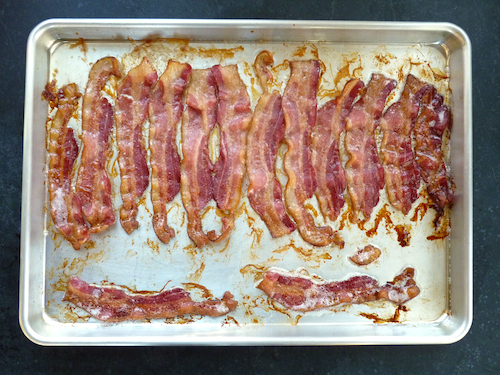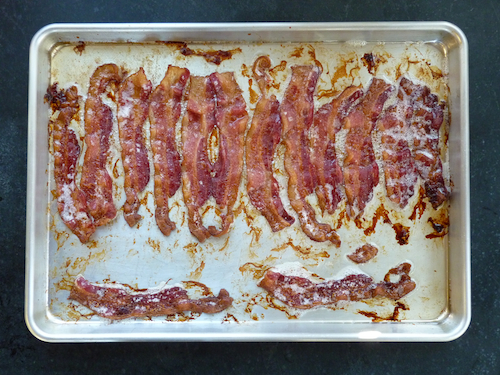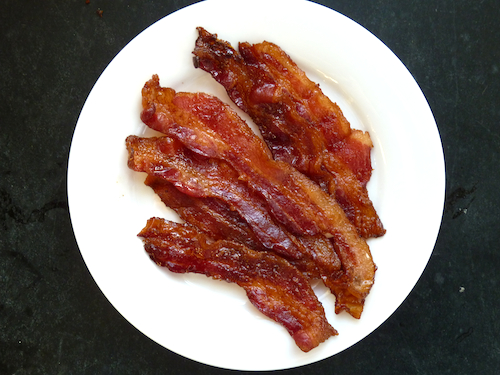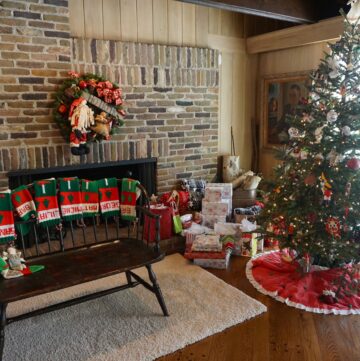The easiest way to cook bacon is in the oven. I’m talking real bacon here, not the precooked microwaveable stuff for people that want to eat bacon but don’t want the bother of cooking it. Cooking bacon in the oven is so easy – no fuss, no turning, no splatters of hot oil on hands or cooktop – that you might as well eat the real thing. One thick, crisp, smoky bite and you’ll remember how much better real bacon is than convenience bacon.
Bacon is the original junk food – marginally nutritious and dangerously tasty. But compared to what junk food has become in the age of manufactured food, an occasional indulgence in real bacon seems almost quaint. We know what it is (pork belly in the US; back loin in Canada) and generally how it’s made (sugar, salt, preservative). In the old days the preservative was saltpeter, also used in gunpowder. These days home curers use “pink salt,” which is salt with sodium nitrite and pink coloring added.
Bacon and other cured meats have been linked to cancer by some studies in recent years, primarily blamed on sodium nitrite, and interestingly the US saw a sharp drop in gastric cancer after it changed guidelines for curing meats in the 1920s that significantly reduced nitrite content. These days industrial producers of bacon may also add phosphates and other chemicals to speed the curing process as well as artificial smoke flavoring in lieu of actually smoking the pork belly.
Uncured bacon is also available. Because it is light on preservatives – of course the salt and sugar act as natural preservatives – it doesn’t keep as long as regular bacon. I buy Coleman’s Natural Uncured Bacon, which is sold in a three-pack at Costco. I keep it in the freezer and defrost it as needed, either overnight in the fridge or plopped in a warm water bath for immediate use (still in its plastic packaging of course – no one wants soggy bacon). Because it’s all fat, frozen bacon defrosts in no time.
Microwaving bacon is particularly hazardous, not just because it is more processed than regular bacon to make it more “convenient” but also because the bacon cooks in plastic. Heating plastic weakens it and makes it more prone to breakdown, and heating food directly in plastic is particularly ill-advised. When heated, chemicals in the plastic can leach into food, and fatty or acidic foods are most susceptible. To me the convenience of three minutes in the microwave over 15 minutes in the oven is not worth the health risk – or the flavor sacrifice.
Lay bacon slices flat in a rimmed baking sheet or jelly roll pan. Slices can be touching but not overlapping; they will shrink during cooking.
You can turn the pan once during baking if it seems to be cooking unevenly. I run my oven on convection, and it cooks evenly enough that I don’t bother turning. Watch carefully toward the end to make sure it doesn’t burn. This is my bacon at 15 minutes.
We like our bacon crispy, so I cooked it another five minutes.
That’s it! A whole pound of bacon cooked perfectly with almost zero effort. Bacon in the oven also doesn’t curl up the way it does on the stovetop. Save the bacon grease for cooking – it’s fantastic for eggs, potatoes, dark greens, cornbread. Or dispose of it in a recycled can. Just don’t put bacon grease (or any animal fat, which solidifies at room temperature) down the drain, or it will stick in your plumbing sort of the way too much food like this will stick in your arteries.
I may have just ruined the idea of bacon. But doesn’t it look good? As my wise mama – the original chinese grandma – says, everything in moderation. Savor every crisp, salty-sweet bite.
Bacon in the Oven
The only way I cook bacon is in the oven. Cooks without fuss – no turning, no hot oil splatters on hands and cooktop – makes for tidy, flat strips. A pound of bacon cooks itself in the oven while I make french toast or eggs on the stovetop.
Ingredients
- 1 pound bacon (preferably nitrate-free)
Directions
- Preheat oven to 400 degrees F.
- Place bacon strips in single layer on jelly roll pan or rimmed baking sheet. Strips can be touching but not overlapping; they will shrink during cooking.
- Cook 15-20 minutes, checking in occasionally. If you find one side is cooking faster than another, turn the pan once during cooking. Cook to desired crispness, watching carefully toward the end.
- Use pancake turner to loosen bacon strips from baking sheet. Place bacon strips on paper towel and dab with another paper towel to absorb excess grease.
Notes
- Don’t dispose of bacon grease (or any fat that is solid at room temperature) in the sink – it will stick in your plumbing and create clogging issues.
- To save the bacon grease for future cooking, let it cool until warm (it will still be liquid but thicker). Pour into a glass dish or jar, where it will cool into a white solid. I am lazy and don’t strain mine – i just stop pouring when it gets to the little browned bits. But to be fastidious you can pour the bacon grease through a mesh strainer or cheesecloth (a paper towel will work in a pinch too, though it will absorb some of the grease). Bacon grease will keep indefinitely in the refrigerator.
- To dispose of bacon grease, let it cool until warm and pour it into a used can from the recycling bin. When it has cooled to a solid you can put it into the trash. You don’t want to put hot oil in the trash, or it will melt a hole in your trash bag.
Here’s the link to a printable version.









We baked bacons in the oven today for our breakfast. My husband actually told me about CG way of doing it. This is really the perefct and the easiest way to make beacons…no more cooking beacons on the pan for me from now on. Thanks for sharing!
Hi, found your post by using google. My problem with cooking bacon in the oven is it literally started smoking in the oven. What did I do wrong??
hi shasta – maybe your oven runs hot? you could try it at 350 degrees F and see if that works better. may take a few minutes longer. i’ve never had excessive smoke, and i’ve used this method in different ovens. i googled the problem, and some people say maybe to try a leaner bacon (haha), or put the bacon on a broiler rack so that the fat drips down as the bacon cooks. hope that helps – let me know how it goes.
Interesting. I thought I was the only person who did something like this. I broil bacon and sausage in the oven because it’s less messy than frying. I usually broil one side, pop it out, turn it over and broil the other side.
hi wolfsbane – very interesting, broiling sounds faster than baking. though broiling is higher risk! i’ve burned too many things in the broiler with a few seconds’ inattention. =P
Yeah, burning can happen easily. I usually put a timer on when I’m broiling. I check every two minutes and then every one minute when it’s almost done. That helps not to forget. Better than a wailing smoke alarm. 😉
It really works the best with sausage. Keep turning until all four sides are nicely browned.
As for chemical free bacon, growing up my friend’s family had a dairy farm and used to feed their hogs exclusively on milk. The fat was pure opaque white unlike the off white and translucent of store bought. It made the most interesting tasting bacon I’ve ever tasted.
hi wolfsbane – that is fascinating! was it better than regular bacon?
I’m not sure I’d say it was better, just different. It wasn’t smoked and had a slightly sweet flavor to it. Probably from the lactose in the milk.
I bake it as well, and I use a foil covered pan. Cooks just as well. Even less clean up!
hi AMC – smart thinking! thanks so much for sharing the tip. =)
For easy clean-up and no sticking, I line my pan with non-stick aluminum foil.
hi mariav – great idea, thanks for sharing!